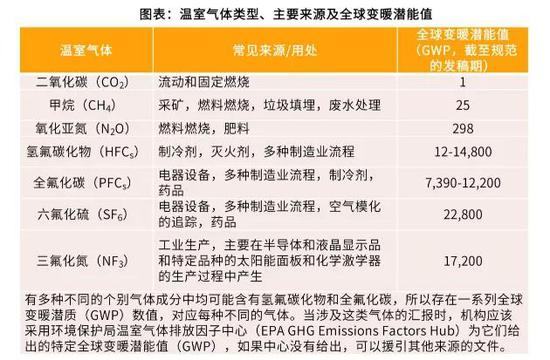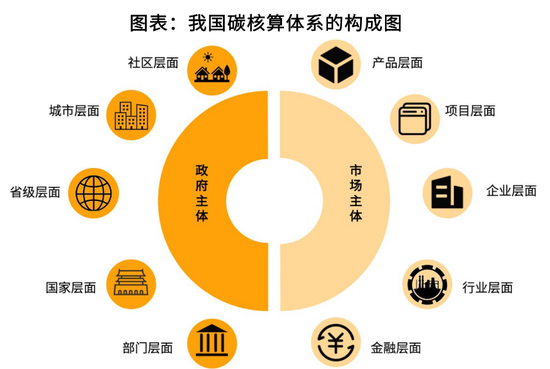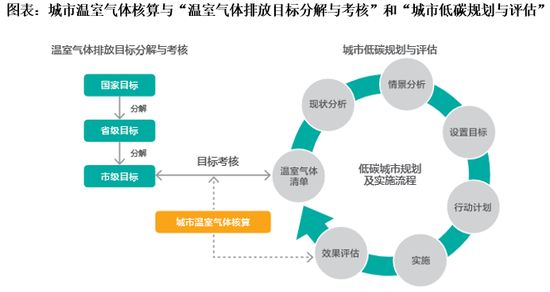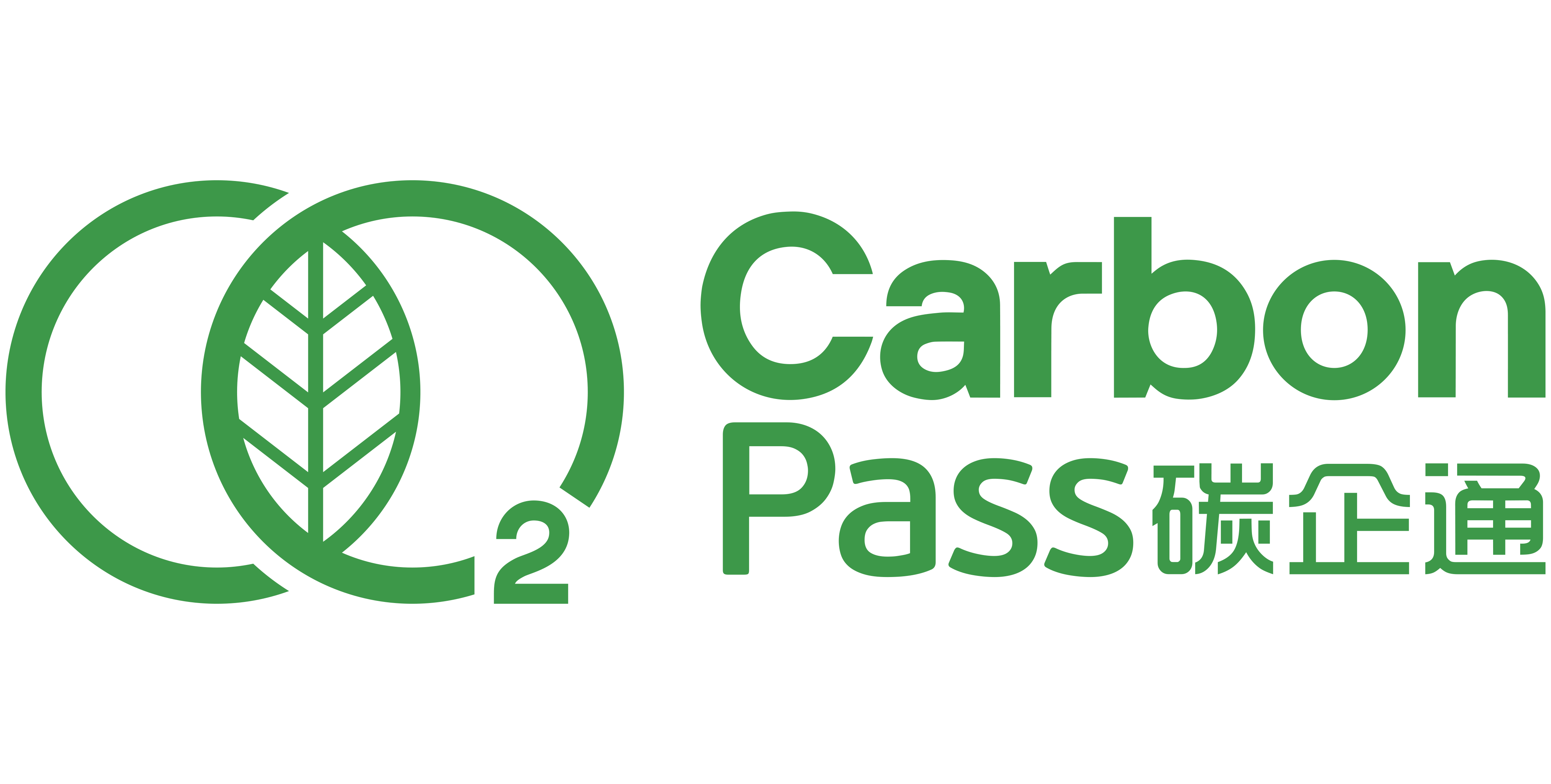Explore the concept, method and system of carbon accounting
summary
一、What is carbon accounting?
Since the adoption of the "Kyoto Protocol" in 1997, countries around the world have carried out a series of emission reduction measures to deal with climate change brought about by industrialization. However, different countries, different regions, different companies and other emission control entities need to rely on scientific data to clarify carbon reduction targets and measure carbon reduction results. Carbon accounting is a measure of the direct and indirect emissions of carbon dioxide and its equivalent gases from industrial activities into the Earth's biosphere. It can be seen that, in terms of accounting objects, carbon accounting needs to include at least the following two conditions: one is to delineate the gases that cause the greenhouse effect, and the other is to determine the main body of industrial activities.
Greenhouse gases are natural and man-made gaseous components of the atmosphere that absorb and re-emit infrared radiation, including carbon dioxide (CO2), methane (CH4), nitrous oxide (N2O), hydrofluorocarbons (HFCs), perfluorocarbons ( PFCs), sulfur hexafluoride (SF6) and nitrogen trifluoride (NF3), etc. Since different gases have different effects on the greenhouse effect, the United Nations Intergovernmental Panel on Climate Change (IPCC) proposed the concept of carbon dioxide equivalent (CO2e) to uniformly measure the impact of these gas emissions on the environment . Based on the Global Warming Potential (GWP), you can see the degree to which different gases contribute to the greenhouse effect relative to carbon dioxide.
In addition, only for energy activities and industrial production processes, according to the "Guidelines for the Preparation of Provincial Greenhouse Gas Inventories", HFCs, PFCs and SF6 mainly involve a few industrial production processes such as aluminum and magnesium, while N2O has long been included in the scope of air pollution monitoring. Therefore, the main objects of carbon accounting for most enterprises are CO2 and CH4. According to the "2017 China Greenhouse Gas Bulletin", carbon dioxide (CO2) and methane (CH4) are the main and secondary long-lived greenhouse gases that affect the earth's radiation balance, and the total radiation produced by the increase in the concentration of all long-lived greenhouse gases The contribution rates in forcing are about 66% and 17%, respectively.

资料来源:Federal Greenhouse GasAcing and Reporting Guidance
From the perspective of industrial activities, according to the "IPCC Guidelines for National Greenhouse Gas Emission Inventories" and "Guidelines for the Preparation of Provincial Greenhouse Gas Inventories", carbon accounting mainly covers five activities: energy activities, industrial production, agricultural production, forestry and land use change and waste disposal.
For the above-mentioned accounting subjects, carbon accounting can generate different types of carbon accounting results based on factors such as data sources, measurement methods, data forms, data quality, measurement regions, and time ranges.
Two、What are the methods of carbon accounting?
The most important forms of carbon accounting can be divided into two methods based on measurement and calculation. Specifically, from the perspective of existing accounting methods for greenhouse gas emissions, they can be summarized into three types: emission factor method, mass balance method, and actual measurement method. . At present, the greenhouse gas quantification methods used in the 24 guidelines issued by the National Development and Reform Commission only include the emission factor method and the mass balance method. Emission units should give priority to the actual measurement of the low calorific value and carbon content of fossil fuels.
(1) Emission factor method (based on calculation)
The emission factor method is the most widely used carbon accounting method. According to the basic equation of carbon accounting provided by IPCC:
Greenhouse gas (GHG) emissions = activity data (AD) x emission factor (EF)
Among them, AD is the amount of production or consumption activities that lead to greenhouse gas emissions, such as the consumption of each fossil fuel, the consumption of limestone raw materials, the net purchased electricity, the net purchased steam, etc.; Coefficients corresponding to horizontal data, including carbon content per unit calorific value or elemental carbon content, oxidation rate, etc., which represent the greenhouse gas emission coefficient per unit of production or consumption activities. EF can either directly adopt the known data provided by IPCC, US Environmental Protection Agency, European Environmental Agency, etc. (that is, the default value), or it can be estimated based on representative measurement data. my country has set national parameters based on the actual situation. For example, Appendix II of the "Guidelines for Accounting and Reporting Greenhouse Gas Emissions of Enterprises in Other Industries (Trial)" provides default value data for common fossil fuel characteristic parameters.
This method is applicable to the relatively macro accounting level of the country, province, city, etc., and can roughly control the overall situation of a specific region. However, in actual work, due to regional differences in energy quality and unit combustion efficiency, various energy consumption statistics and carbon emission factor measurements are prone to large deviations, which become the main source of errors in carbon emission accounting results.
(2) Mass balance method (based on calculation)
The mass balance method can calculate the proportion of new chemical substances consumed to meet the capacity of new equipment or to replace and remove gases based on the new chemical substances and equipment used in national production and life every year. For CO2, under the carbon mass balance approach, carbon emissions are obtained by subtracting non-CO2 carbon output from the input carbon content:
Carbon dioxide (CO2) emission = (raw material input x raw material carbon content - product output x product carbon content - waste output x waste carbon content) x 44/12
Among them, is the conversion coefficient of carbon into CO2 (that is, the relative atomic mass of CO2/C). The carbon mass balance method based on specific facilities and technological processes is used to calculate emissions, which can reflect the actual emissions where carbon emissions occur. Not only can it distinguish the differences between various types of facilities, but it can also distinguish between individual and partial equipment. This method is more convenient especially when the equipment is constantly updated during the interim. Generally speaking, the main accounting method for corporate carbon emissions is the emission factor method, but in industrial production processes (such as desulfurization process emissions, chemical production enterprise process emissions, and other non-fossil fuel combustion processes), the carbon balance method can be selected depending on the situation.
(3) Actual measurement method (based on measurement)
The actual measurement method is based on the basic data measured by the emission sources, and the relevant carbon emissions are summarized. Here also include two kinds of actual measurement methods, namely on-site measurement and off-site measurement.
On-site measurement is generally equipped with a carbon emission monitoring module in the smoke emission continuous monitoring system (CEMS), and directly measures the emission through continuous monitoring of concentration and flow rate; off-site measurement is to collect samples and send them to relevant monitoring departments, and use special detection Equipment and techniques for quantitative analysis. Compared with the two, the accuracy of on-site measurement is significantly higher than that of off-site measurement due to problems such as adsorption reaction and dissociation of the sampled gas during off-site measurement.
The United States is the most vigorous in promoting the actual measurement method. As early as 2011, the mandatory installation of carbon emission measurement began: the U.S. Environmental Protection Agency stipulated in the 2009 "Mandatory Regulations on Greenhouse Gas Emissions Reporting" that all emissions exceeding 25,000 tons of carbon dioxide equivalent per year Since 2011, all smoke continuous online monitoring systems (CEMS) must be installed and reported online to the US Environmental Protection Agency.
The European Commission launched the EU carbon emissions trading system in 2005 and officially launched the monitoring of CO2 emissions. However, only 155 emission units (accounting for 1.5%) in 23 countries currently use CEMS (Continuous Monitoring System), mainly in Germany and the Czech Republic. ,France.
China's thermal power plants have basically installed CEMS, and have the basis for using CEMS to monitor CO2 emissions. On May 27, the country's first accurate measurement system for carbon emissions in the power industry was launched in Jiangsu. It is the first in China to use the actual measurement method for real-time online monitoring and accounting of carbon emissions, and it is expected to be popularized nationwide soon.
Three、Composition And Standards Of Carbon Accounting System
In view of the fact that the realization of the goal of carbon neutrality involves various cross-departmental, cross-level, and cross-organizational social actors from the central government to the local government, from the government to the enterprise, the composition of the carbon accounting system has thus become a huge intertwined and complex network—— As big as the country, as small as the product. Up to now, a route of independent promotion and interactive feedback by government entities and market entities under a common goal has been developed.

The carbon accounting mechanism is a multi-subject system, and the roles and responsibilities of each subject will directly affect the accuracy and nature of the accounting results. Overall, carbon accounting methods can be divided into two categories: top-down and bottom-up. The former mainly refers to macroscopic measurement at the national or government level, while the latter includes self-assessment and disclosure by enterprises, and local reports to the central government. Summary, and countries submit feedback to the international community.
From an international perspective, international organizations or international agreements mainly rely on governments and enterprises to conduct independent accounting and reporting to calculate carbon accounting results. For top-down calculations, the "IPCC Guidelines for National Greenhouse Gas Inventories" is the mainstream international standard, and for bottom-up calculations, the GHG Protocol series of standards are the most widely used. These standards and guidelines issued by non-governmental organizations encourage entities such as countries, cities, communities, and enterprises to report and communicate accounting results, so as to ensure the consistency of public reports. Taking the carbon accounting report released by the International Energy Agency (IEA) as an example, its data sources are mainly the monthly data submitted by the country to the IEA Energy Data Center, real-time data from power system operators around the world, and national management departments. statistics, etc.
Although the specific process of carbon accounting is objective measurement and calculation, there are still huge gaps and differences in the delineation of the measurement range and the formulation of specific standards, which also brings uncertainty. So far, China has achieved certain results in the integration of carbon accounting frameworks and the formulation of standards. At the same time, although there are widely recognized principles and standards in the international community, in specific implementation, their data sources, collection and measurement methods, data presentation methods, and reporting methods still have their own emphasis.
1. National level
According to the requirements of the United Nations Framework Convention on Climate Change (UNFCCC, hereinafter referred to as the "Convention"), Annex I parties to the Convention (mainly developed countries) need to compile and submit national greenhouse gas inventories every year, while non-Annex I parties Prepare and submit national GHG inventories, as appropriate. The first edition of the "IPCC Guidelines for National Greenhouse Gas Inventories" issued by the IPCC in 1995 (hereinafter referred to as the "IPCC Guidelines") is the main method and rule for countries in the world to compile greenhouse gas inventories, and the "2006 IPCC National Greenhouse Gas Inventory Compilation Guidelines "IPCC 2006 Guidelines for National Greenhouse Gas Inventories 2019 Revision" have been updated and revised. The revised version in 2006 mainly calculates greenhouse gas emissions and eliminations from five parts: energy, industrial process and product use, agriculture, forestry and other land use, and waste. Its accounting methods include emission factor method and mass balance method.
Internationally, the International Energy Agency (IEA), the World Resources Institute (WRI), and the World Bank (WB) have established carbon emission databases covering countries around the world. However, under the estimation of different energy consumption and emission factors, the calculation results of each database are different, and the databases of international organizations generally overestimate my country's carbon emissions. For example, an article published in Nature in 2015 pointed out that China's energy consumption in 2000-2012 was 10% higher than official statistics, the coal emission factor was 40% lower than the IPCC default value, and the carbon emissions of cement production were lower than estimated 45%.
At present, my country has completed five years of carbon emission accounting work in 1994, 2005, 2010, 2012 and 2014, which were released in three "National Communications on Climate Change" and two "Biennial Update Reports on Climate Change" respectively. middle. However, the carbon accounting results of various domestic institutions are also quite different. For example, in the "Third National Information Bulletin", my country's carbon dioxide emissions (including carbon dioxide produced by energy combustion and industrial engineering) in 2005 and 2010 were 6.381 billion tons and 8.707 billion tons respectively. The carbon accounting results are 5.35 billion tons and 7.75 billion tons, 19.3% and 12.3% higher respectively.
2. Provincial level
After the State Council promulgated the "China's National Climate Change Program" in 2007, the National Development and Reform Commission issued the "Provincial Greenhouse Gas Inventory Guidelines (Trial)" (hereinafter referred to as "Provincial Guidelines") in May 2011 to help achieve the goal of 2009. The goal proposed by the State Council in 2020 is to reduce carbon dioxide emissions per unit of GDP by 40%-45% compared with 2005.
Similar to the "IPCC Guidelines", the "Provincial Guidelines" provide guidance on my country's provincial greenhouse gas inventories from five aspects: energy activities, industrial production processes, agriculture, land use change and forestry, and waste treatment. But what is special about it is that the "Provincial Guide" sets an emission factor for the carbon emissions caused by inter-provincial power dispatching, indirect emissions of carbon dioxide from electricity transferred (outgoing) = transferred (outgoing) electricity x average emission factor of regional grid power supply . At the same time, the "Provincial Guide" provides different levels of methods and optional default values in combination with my country's actual situation. However, there is no official disclosure of the carbon emission calculation results of each province in my country.
3. City level
Under the influence of the requirements of the "Provincial Guidelines" and the demand for the construction of low-carbon demonstration cities, the preparation of my country's greenhouse gas inventory has been gradually refined. Jiangxi, Henan, Shanxi, Shaanxi, Zhejiang, Jiangsu and other provinces have launched greenhouse gas inventories for each city (district) compiling work. In the specific work, the preparation of greenhouse gas inventories at the city level in my country is mainly based on the "Provincial Guidelines", "IPCC Guidelines" and the 24 "Guidelines for Accounting and Reporting Greenhouse Gas Emissions of Industries and Enterprises" issued by the National Development and Reform Commission (hereinafter referred to as "Industry Guidelines"), etc. . In addition, there are corresponding international standards for reference.
The Greenhouse Gas Protocol (GHG Protocol) series of standards are jointly issued by the World Business Council for Sustainable Development (WBCSD) and the World Resources Institute (WRI), including corporate carbon accounting and reporting standards, project carbon accounting standards, city and community standards, etc. A carbon verification and reporting guideline standard covering the six greenhouse gases specified in the Kyoto Protocol. The GHG Protocol is not only the reference basis for the greenhouse gas management standard system (ISO 14064), but also the document basis for the National Development and Reform Commission to formulate the Industry Guidelines.
In September 2013, the World Resources Institute (WRI), together with the Institute of Urban Development and Environment of the Chinese Academy of Social Sciences, the World Wide Fund for Nature (WWF) and the Institute for Sustainable Communities (ISC), developed the "Urban Greenhouse Gas Accounting Program" for Chinese cities. Tool (Beta 1.0)" (the "Tool"). The urban GHG accounting in the tool is divided into six steps, namely, determining the accounting boundary, determining the emission sources for accounting and reporting, determining the calculation method, collecting data, calculating GHG emissions, and reporting GHG emissions. Among them, in view of the high cost and heavy workload of the measured working equipment, the tool still adopts the emission factor method, but the order of priority is set as measured emission factors, regional emission factors (provincial or inter-provincial), national emission factors and IPCC emission factors .

Source: Urban Greenhouse Gas Balancer (Beta 1.0)
4. Community level
A community is a living community with multiple social relationships formed by people living in a certain area, so the accounting of community carbon emissions should take the geographical boundary of the community as the accounting boundary. Generally speaking, the carbon emissions generated by the community mainly come from the energy consumption of life, and the types of carbon emission activities can be divided into two categories: one is direct carbon emission activities, such as fossil fuel combustion and mobile source combustion (such as transportation); The second is indirect carbon emission activities, such as electricity consumption and heat consumption. Under the limitation of equipment, community carbon accounting is mainly calculated based on the emission factor method.
The GHG Protocol released the Global Protocol for Community-Scale Greenhouse Gas Emissions (GPC) in 2012, which clarified six principles for community carbon accounting: relevance, completeness, consistency, transparency, Accuracy, measurability, and developed the "GPC 2012 Carbon Accounting Report Pilot Framework".
5. Department level
Judging from the promotion of various ministries and commissions for carbon peaking and carbon neutrality goals, the National Development and Reform Commission will make leading arrangements and overall layout. Policy subjects and priorities, while finance (involving the central bank, the Ministry of Finance, the State Administration of Taxation, and the China Securities Regulatory Commission), science and technology (involving the Ministry of Science and Technology), and ecology (involving the Ministry of Ecology and Environment, the Ministry of Agriculture and Rural Affairs, the Ministry of Natural Resources, and the State Forestry and Grassland Administration) are Three auxiliary areas.
Combined with the "Provincial Guidelines", carbon accounting will also involve multi-sector coordination, including energy activities (involving the National Energy Administration), industrial production processes (involving the Ministry of Industry and Information Technology), agriculture (involving the Ministry of Agriculture and Rural Affairs), land use change and forestry (involving the Ministry of Natural Resources and the State Forestry and Grassland Administration), waste disposal (involving the Ministry of Ecology and Environment), etc.
In addition, for energy use alone, there is a sectoral approach in addition to the emission factor approach (reference approach). The departmental method is mainly based on the department, and conducts greenhouse gas emission accounting by department, fuel type, and major equipment. This method requires a large amount of data, but it is more accurate. Specifically, the activities of each economic sector can be taken as the accounting object, and the fuel consumption of different types within a certain period of time (such as 1 year) can be multiplied by the three parameters of fuel low calorific value, carbon content per unit calorific value, and oxidation rate to obtain the The total amount of carbon emissions generated by energy use in economic activities can be obtained after summing up. The International Energy Agency (IEA) adopts the sectoral approach for carbon accounting in the energy sector.
6. Financial aspect
For financial institutions' carbon emission accounting, the Carbon Acing Financial Alliance (Partnership for Carbon Acing Financials, PCAF) has developed the "Financial Industry Greenhouse Gas Accounting and Reporting Guidelines" (hereinafter referred to as the "Financial Industry Guidelines") to provide financial institutions with detailed methodologies to account for and disclose greenhouse gas emissions related to six types of assets.

Source: The Global GHG Acing & Reporting for the Financial Industry Standard
Based on the GHG Protocol, the "Financial Industry Guidelines" require financial institutions to account and disclose the scope 1 (such as direct emissions from fossil fuel combustion, etc.) and scope 2 (such as indirect emissions from purchased electricity and heat) emissions of investment and financing customers. For Scope 3 (e.g. suppliers) emissions, the "Financial Industry Guidelines" adopts a phased approach of industry inclusion: the first batch of industries included in the accounting in 2021 include the oil, gas and mining industries; in 2024, the covered industries will be extended to transportation , construction, materials and industrial production; all industries will be covered after 2026.
7. Industry level
From November 2013 to November 2015, the National Development and Reform Commission issued the "Enterprise Greenhouse Gas Emissions Accounting Method and Reporting Guidelines (Trial)" (hereinafter referred to as "Enterprise Guidelines") for 24 industries, including:
The first batch of 10, power generation enterprises, power grid enterprises, iron and steel production enterprises, chemical production enterprises, electrolytic aluminum production enterprises, magnesium smelting enterprises, flat glass production enterprises, cement production enterprises, ceramic production enterprises, civil aviation enterprises;
The second batch of 4, China's oil and gas production enterprises, China's petrochemical enterprises, China's independent coking enterprises, and China's coal production enterprises;
The third batch of 10, papermaking and paper product manufacturing enterprises, other non-ferrous metal smelting and rolling processing enterprises, electronic equipment manufacturing enterprises, mechanical equipment manufacturing enterprises, mining enterprises, food, tobacco and wine, beverage and refined tea enterprises, public buildings Operating units (enterprises), land transportation enterprises, fluorine chemical enterprises, and other industrial enterprises.
The "Guidelines for Enterprises" covers all key industries with high carbon emissions, regulates the accounting of carbon emission data by enterprises and verification agencies, and ensures the accuracy of the basic data of the carbon market.
In December 2017, the National Development and Reform Commission issued the "Notice on Doing a Good Job in 2016 and 2017 Carbon Emission Reporting and Verification and Emission Monitoring Plan Formulation", which clarified the covered industries and codes, covering petrochemical, chemical, building materials, steel, Eight major industries including non-ferrous metals, papermaking, electric power, and civil aviation. Among them, the scope of included enterprises is self-owned power plants with greenhouse gas emissions of 26,000 tons of carbon dioxide equivalent or more in any one year from 2013 to 2017.
Under the guidance of the National Development and Reform Commission's documents, provincial governments are detailing industry carbon emission reporting guidance documents step by step. For example, Guangdong Province compiled the "Guidelines for Reporting Carbon Dioxide Emissions Information of Enterprises (Entities) in Guangdong Province (2014 Edition)" as early as 2014 and revised it year by year; Electricity Production Industry".
8. Enterprise level
The "A Corporate Acing and Reporting Standard" under the GHG Protocol is mainly concerned with how companies calculate greenhouse gases, reporting responsibilities, carbon emission verification, emission reduction accounting, target setting, inventory Unified standards have been put forward in design and other aspects, and the principle of corporate data transparency has been emphasized, that is, companies should disclose the process, procedures, assumptions and limitations of greenhouse gas inventories in a clear manner, and audit, record, file and monitor the data. external validation.
ISO14064-1 is a specification and guideline for the quantification and reporting of greenhouse gas emissions and removals at the organizational level. It specifies in detail the principles and requirements for organizations or companies to design, develop, manage and report GHG inventories. Including the determination of greenhouse gas emission limits, the quantification of the organization's greenhouse gas emissions, and the identification of specific measures or activities to improve the company's greenhouse gas management and other requirements.
According to ISO 14064-1, GHG Protocol's "Company Standards" and other international documents, as well as domestic regulations such as "Enterprise Greenhouse Gas Emissions Accounting Method and Reporting Guidelines (Trial)", enterprises can rely on emission factor method, mass balance method or actual measurement method. Related carbon accounting and reporting. However, if you want to qualify for carbon emissions trading, you need to pass the verification of a third-party agency under my country's carbon emissions monitoring, reporting and verification system (MRV).
For enterprises, on June 1, 2016, the national standard "General Rules for Accounting and Reporting of Greenhouse Gas Emissions of Industrial Enterprises" (GB/T 32150-2015) was implemented, completely replacing the standard "General Rules for Accounting and Reporting of Greenhouse Gas Emissions of Industrial Enterprises" (GB/T 32150-2015) T 15496-2003); since 2019, the Ministry of Ecology and Environment has upgraded the accounting and reporting requirements for carbon emissions to a recommended national standard plan, such as "2020 1771-T-303 Greenhouse Gas Emissions Accounting and Reporting Requirements Part 1 : Power Generation Enterprises”, and extended the coverage to planting enterprises and large-scale livestock and poultry breeding enterprises. For third-party organizations, in 2017, on the basis of ISO 14064, the National Certification and Accreditation Administration Committee issued the industry standard "General Specifications for Greenhouse Gas Emissions Verification of Organizations"; Reference Guide to standardize the verification of an organization's greenhouse gas emissions.
After the implementation of the "National Carbon Emissions Trading Quota Total Setting and Allocation Implementation Plan (Power Generation Industry)" in 2021, domestic power generation enterprises will implement according to national-level documents and standards, and enter the accounting verification and trading under the national carbon market system Contract compliance stage: key emission units in industries other than the power generation industry will continue to conduct accounting reports and transaction performance in accordance with the original management methods of the pilot provinces and cities where they are located.
9. Project level
Project-based accounting, most notably the Clean Development Mechanism (CDM) of the Kyoto Protocol. Through CDM, developed countries can obtain certified emission reductions (CERs) from greenhouse gas emission reduction or absorption projects implemented by developing countries to offset part of their emission reduction obligations under the Kyoto Protocol. The core of CDM is the acquisition of CERs in GHG projects, and this depends on the accounting and certification of the GHG emission reductions of the projects, which is "The GHG Protocol for Project Acing" (The GHG Protocol for Project Acing) in the GHG Protocol series of standards.
In addition, ISO14064 also includes carbon accounting at the project level. In 2006, the International Organization for Standardization (ISO) released the international greenhouse gas emission accounting and verification standard ISO14064, which consists of three parts: the first part, ISO14064-1, is a specification for guiding enterprises/organizations to quantify and report greenhouse gas emissions and elimination, and its functions are similar to those of " Enterprise Accounting GHG Agreement" is similar; the second part of ISO14064-2 focuses on GHG projects aimed at reducing GHG emissions or accelerating the removal of greenhouse gases, which includes determining project baselines and monitoring, quantifying and reporting project performance related to baselines The principles and requirements are also similar to the "Project Accounting GHG Agreement"; the third part, ISO14064-3, explains the actual verification process, which makes ISO14064-3 can be used to guide independent third-party organizations to conduct GHG report verification and claims.
10. Product level
For the carbon emission accounting of products, the Carbon Trust (Carbon Trust) and the UK Department of Environment, Food and Rural Affairs (DEFRA) jointly took the lead, and the British Standards Institution (BSI) formulated the "PAS 2050 Standard" in 2008, which is the world's first The carbon footprint standard of all products. PAS 2050 calculates the greenhouse gas emissions from the whole life cycle of products or services—from raw materials to production (or service supply links), distribution, use and recycling, and according to the global warming of various greenhouse gases Potential (GWP) is converted into CO2 equivalent to reflect the carbon footprint of a product or service and its impact on climate change.
Since 2012, the International Standard Organization ISO has promulgated the product carbon footprint accounting standard ISO14067, which is used to guide the quantification of product carbon footprint and external communication using life cycle assessment methods. The promulgation of ISO14067 is based on existing international standards, such as life cycle assessment (ISO14040 and ISO14044), environmental labels and declarations (ISO14020, ISO14024 and ISO14025), etc. Previously, the international evaluation of product carbon footprint mainly used ISO 14040/44, PAS 2050 and the Product carbon footprint protocol formulated by WRI World Energy Association, while the promulgation of ISO 14067 has formed a market-oriented consensus framework document globally.


